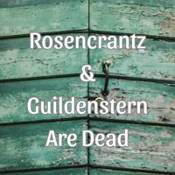
Overview
Synopsis
Prince Hamlet of Denmark sets out to avenge his father’s murder, all the while trying desperately to keep his sanity in one piece. That’s all very well for Hamlet — but how does the prince’s erratic behavior appear to casual bystanders not clued in on Hamlet’s schemes? In Rosencrantz and Guildenstern are Dead, playwright Tom Stoppard turns one of the most famous plays of the Western world on its head by putting two minor characters, Rosencrantz and Guildenstern, and presenting the madcap antics of the royals through their eyes.
Rosencrantz and Guildenstern have been summoned to Elsinore by the king, Claudius. He and Queen Gertrude, wish for Rosencrantz and Guildenstern to glean what sudden sway of madness has affected Hamlet. The duo sets out to achieve their task, meeting a ragged troupe of players along the way. Brief glimpses of scenes from Hamlet show the trials and tribulations of the royals; our two heroes are largely left in a state of waiting. They pass the time playing games, posing questions, and tossing coins, until they gradually realize that their fates have been taken out of their own hands. They are merely characters in a larger story in which they have no say. Part Shakespearean tragedy, part Laurel and Hardy comedy routine, part Waiting for Godot absurdity, Tom Stoppard’s masterful debut play calls fate, free will, art, reality, communication, and the very constructs of theatre into question, all the while leading two most honorable, adventurous, brilliant, and inept characters on their path to their unfortunate, unavoidable, infamous fate.
Show Information
Context
Tom Stoppard first conceived Rosencrantz and Guildenstern Are Dead in 1964, as a one-act play titled Rosencrantz and Guildenstern Meet King Lear. An expanded version debuted with its current title at the 1966 Edinburgh Fringe Festival, produced by a student company called the Oxford Theatre Group. Although the initial production was poorly received overall, one glowing review gave the play enough momentum for a production at London’s Old Vic in 1967. Later that year, the production
to read the context for Rosencrantz & Guildenstern Are Dead and to unlock other amazing theatre resources!Plot
Act One
Two Elizabethans, Rosencrantz and Guildenstern, pass the time by betting on coin flips. Nearly 100 flips in a row have landed on heads, prompting a philosophical discussion on the laws of probability, reality, and supernatural phenomena. Rosencrantz and Guildenstern are traveling to see the King, having been urgently summoned for an unknown reason. A group of Tragedians, led by a Player, arrives. The Player offers a performance, but the troupe can only perform crude, gory
to read the plot for Rosencrantz & Guildenstern Are Dead and to unlock other amazing theatre resources!Characters
| Name | Part Size | Gender | Vocal Part |
|---|---|---|---|
|
Lead |
Male |
Non-singer |
|
|
Lead |
Male |
Non-singer |
|
|
Supporting |
Male |
Spoken |
|
|
Supporting |
Male |
Non-singer |
|
|
Featured |
Male |
Spoken |
|
|
Featured |
Male |
Spoken |
|
|
Featured |
Male |
Spoken |
|
|
Featured |
Female |
Spoken |
|
|
Featured |
Male |
Spoken |
|
|
Featured |
Female |
Spoken |
|
|
Featured |
Male |
Spoken |
|
|
Ensemble |
Either Gender |
Spoken |
Songs
A song with an asterisk (*) before the title indicates a dance number; a character listed in a song with an asterisk (*) by the character's name indicates that the character exclusively serves as a dancer in this song, which is sung by other characters.
Monologues
Scenes
Key Terms
Absurdism is a 20th-century theatrical style that reflects the belief that life lacks inherent meaning. Playwrights such as Samuel Beckett and Eugène Ionesco used illogical dialogue, repetition, and surreal situations. The genre emphasizes the futility of human struggle and the breakdown of communication.
An adaptation is a reworking of a story from one medium or cultural context into another, such as turning a novel into a play or updating a classic play’s setting. Adaptations often reinterpret themes, characters, and style for new audiences. They can range from faithful recreations to bold reimaginings.
An actor's first performance or appearance in a professional setting.
Asserting opinions rigidly; often used to describe characters with inflexible worldviews.
A philosophical movement emphasizing individual existence and responsibility, often reflected in modern theatre.
A mood or character trait in drama denoting sadness, introspection, or despair, often linked to tragic figures.
A heightened, emotional style of performance or storytelling that exaggerates plot and character traits. Melodrama is often associated with 19th century theatre and explores themes of good versus evil.
A form of self-referential drama where the play draws attention to its own theatricality. This device challenges the audience’s suspension of disbelief and is used in Epic Theatre and postmodern works.
A system of thought exploring existence, ethics, or knowledge, often influencing theatrical movements like existentialism or realism.
The range of plays, roles, or musical works that a performer or company is prepared to perform. Repertoire reflects an artist's or theatre’s experience and identity.
A dramatic movement featuring illogical dialogue, cyclical plots, and existential themes, reflecting the absurdity of human existence.
An actor who specializes in tragic roles, often possessing a powerful voice and gravitas suitable for dramatic intensity.
A company or group of actors who perform together, often touring or working as a repertory ensemble.
Videos
Quizzes
Themes, Symbols & Motifs
Sorry! We do not currently have learning modules for this guide.
Quote Analysis
Sorry! We do not currently have learning modules for this guide.

